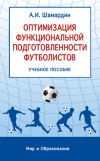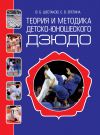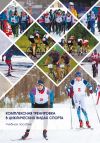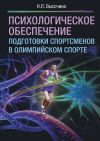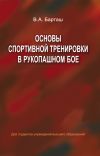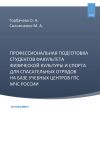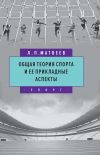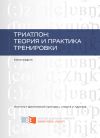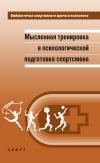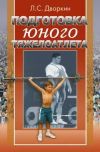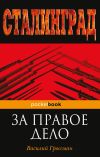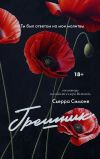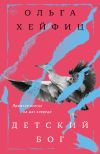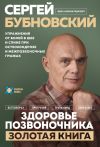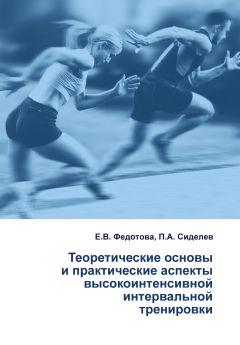
Автор книги: П. Сиделев
Жанр: Спорт и фитнес, Дом и Семья
Возрастные ограничения: +16
сообщить о неприемлемом содержимом
Текущая страница: 13 (всего у книги 14 страниц)
107. Hall, A.J. The Effects of Sprint Interval Training on Physical Performance: A Systematic Review and Meta-Analysis / A.J. Hall, R.R. Aspe, T.P. Craig [et al.] // Journal of Strength and Conditioning Research. – 2023. – Vol. 37. – № 2. – P. 457–481.
108. Hannan, A.L. High-intensity interval training versus moderate-intensity continuous training within cardiac rehabilitation: a systematic review and meta-analysis / A.L. Hannan, W. Hing, V. Simas [et al.] // Open Access J Sports Med. – 2018. – Vol. 26. – № 9. – P. 1–17.
109. Harley Y.X.R., Kohn T. A., Gibson A. St Clair, Noakes T. D., Collins M. Skeletal muscle monocarboxylate transporter content is not different between black and white runners // Eur J Appl Physiol (2009) 105:623–632 DOI 10.1007/s00421-008–0942-0.
110. Harre, D. Principles of sports training: introduction to the theory and methods of training / D. Harre, J. Barsch. – Berlin: Sportverlag, 1982. – 232 p.
111. Harris RC, Söderlund K, Hultman E. Elevation of creatine in resting and exercised muscle of normal subjects by creatine supplementation. Clin Sci (Lond). 1992;83(3):367–74.
112. Hashimoto T, Masuda S, Taguchi S, Brooks G. 2005. Immunohistochemical analysis of MCT1, MCT2 and MCT4 expression in rat plantaris muscle. J Physiol 567: 121–129.
113. Hashimoto, T. Colocalization of MCT1, CD147, and LDH in mitochondrial inner membrane of L6 muscle cells: evidence of a mitochondrial lactate oxidation complex / T. Hashimoto, R. Hussien, G.A. Brooks // American Journal of Physiology-Endocrinology and Metabolism. – 2006. – Vol. 290. – № 6. – P. E1237-E1244.
114. Hashimoto, T. Mitochondrial lactate oxidation complex and an adaptive role for lactate production / T. Hashimoto, G.A. Brooks // Med Sci Sports Exerc. – 2008. – Vol. 40. – № 3. – P. 486–494.
115. Hawley, J.A., Myburgh, K.H., Noakes, T.D. and Dennis, S.C. (1997). Training techniques to improve fatigue resistance and enhance endurance performance. Journal of Sports Sciences. 15, 325–333.
116. Hazell, T.J. 10 or 30-s sprint interval training bouts enhance both aerobic and anaerobic performance / T.J. Hazell, R.E. Macpherson, B.M. Gravelle, P.W. Lemon // Eur J Appl Physiol. – 2010. – Vol. 110. – № 1. – P. 153–160.
117. Hejazi S. M. Effects of High Intensity Interval Training on Plasma Levels of GH and IGF-I // International Journal of Medical Research and Health Sciences. – 2017. – Vol. 6. – № 4. – P. 55–59.
118. Helgerud, J. Aerobic high-intensity intervals improve VO2max more than moderate training / J. Helgerud, K. Høydal, E. Wang [et al.] // Med Sci Sports Exerc. – 2007. – Vol. 39. – № 4. – P. 665–671.
119. Hill, D.W. and Rowell, A.L.(1997). Responses to exercise at the velocity associated with VO2max. Medicine and Science in Sports and Exercise. 29 (1), 113–116.
120. Hill-Haas, Stephen & Dawson, Brian & Impellizzeri, Franco & Coutts, Aaron. (2011). Physiology of Small-Sided Games Training in Football. Sports medicine (Auckland, N.Z.). 41. 199–220. 10.2165/11539740-000000000-00000.
121. Hoshino, D. High-intensity interval training enhances oxidative capacity and substrate availability in skeletal muscle / D. Hoshino, Y. Kitaoka, H. Hatta // J Phys Fitness Sports Med. – 2016. – Vol. 5. – № 1. – P. 13–23.
122. http://www.racingpast.ca/john_contents.php?id=112. [Accessed: 07 July, 2023].
123. http://www.racingpast.ca/john_contents.php?id=138. [Accessed: 07 July, 2023].
124. http://www.racingpast.ca/john_contents.php?id=146. [Accessed: 07 July, 2023].
125. http://www.racingpast.ca/john_contents.php?id=147. [Accessed: 07 July, 2023].
126. Hultman E et al. Muscle creatine loading in men. J Appl Physiol (1985), 1996. 81(1): p. 232–237.
127. Hurst, C. High-Intensity Interval Training: A Potential Exercise Countermeasure During Human Spaceflight / C. Hurst, J.P.R. Scott, K.L. Weston and M. Weston // Front. Physiol. – 2019. – Vol. 10. – P. 1–7.
128. Izumi Tabata: Interview with the Founder of the World-Renowned Tabata Protocol: Ritsumeikan Univ. http://www.ritsumei.ac.jp/eng/html/research/areas/feat-researchers/interview/izumi_t.html/
129. Jacob, N., So, I. et al (2021). Effects of high-intensity interval training on blood lactate levels in healthy adults: protocol for systematic review and network meta-analyses. 10.21203/rs.3.rs-471 202/v1.
130. Jacobs, R. Improvements in exercise performance 1 with high-intensity interval training 2 coincide with an increase in skeletal muscle mitochondrial content and function / R. Jacobs, D. Flück, T.C. Bonne [et al.] // Journal of applied physiology. – 2013. – Vol. 115. – № 6. – P. 785–793.
131. Jamnick NA, Pettitt RW, Granata C, Pyne DB, Bishop DJ. An examination and critique of current methods to determine exercise intensity. Sports medicine. Berlin: Springer; 2020. p. 1729–56.
132. Javaloyes, A. Training Prescription Guided by Heart Rate Variability in Cycling / A. Javaloyes, J.M. Sarabia, R.P. Lamberts, M. Moya-Ramon // International journal of sports physiology and performance. – 2019. – Vol. 14. – № 1. – P. 23–32.
133. Jemma J, Hawley J, Kumar D, Singh V, Cosic I. (2005) Endurance training of trained athletes-an electromyogram study. Conf Proc IEEE Eng Med Biol Soc. 2005;7:7707–9.
134. Juel C, Klarskov C, Nielsen JJ, Krustrup P, Mohr M, Bangsbo J Effect of high-intensity intermittent training on lactate and H+ release from human skeletal muscle // Am J Physiol Endocrinol Metab. 2004 Feb;286(2):E245–51. Epub 2003 Oct 14.
135. Juel, C. Lactate transport in skeletal muscle – role and regulation of the monocarboxylate transporter / C. Juel, A.P. Halestrap // The Journal of physiology. – 1999. – Vol. 517. – № 3. – P. 633–642.
136. Julio U., Panissa V. L. G., Paludo Ana C., et al (2020) Use of the anaerobic speed reserve to normalize the prescription of high-intensity interval exercise intensity, European Journal of Sport Science, 20:2, 166–173, DOI: 10.1080/17461391.2019.1624833.
137. Kamandulis S, Bruzas V, Mockus P, Stasiulis A, Snieckus A, Venckunas T. Sport-Specific Repeated Sprint Training Improves Punching Ability and Upper-Body Aerobic Power in Experienced Amateur Boxers. J Strength Cond Res. 2018 May;32(5):1214–1221.
138. Kao, S.C. Acute effects of intense interval versus aerobic exercise on children's behavioral and neuroelectric measures of inhibitory control / S.C. Kao, N. Baumgartner, K. Noh [et al.] // Journal of Science and Medicine in Sport. – 2023. – Vol. 26. – № 6. – P. 316–321.
139. Kendall, B.J. Acute high-intensity interval training improves motor skill acquisition / B.J. Kendall, N.J. Siekirk, Q. Lai // The Journal of sports medicine and physical fitness. – 2020. – Vol. 60. – № 8. – P. 1065–1071. DOI: 10.23736/S0022–4707.20.10580-2.
140. Kendall, B.J. Effects of Acute High-Intensity Interval Training on Information Processing Speed / B.J. Kendall, N.J. Siekirk, Q. Lai // Journal of Strength and Conditioning Research. – 2022. – Vol. 36. – № 11. – P. 3081–3086.
141. Kilen, A. Effects of 12 Weeks High-Intensity & Reduced-Volume Training in Elite Athletes / A. Kilen, T.H. Larsson, M. Jørgensen [et al.] // PLoS ONE – 2014. – Vol. 9. – № 4. – P. 1–8.
142. Kirchenberger, T. Effects of Moderate– versus Mixed-Intensity Training on VO2peak in Young Well-Trained Rowers / T. Kirchenberger, S. Ketelhut, R.G. Ketelhut // Sports. – 2021. – Vol. 9. – № 7. – P. 1–9.
143. Kirkpatrick M.L. Effects of active versus passive recovery on blood lactate and performance in repeated Wingate tests: A Thesis Presented to The Faculty of Humboldt State University In Partial Fulfillment of the Requirements for the Degree Master of Science in Kinesiology: Exercise Science. 2017. -76 p.
144. Kitaoka Y., Hoshino D., Hatta H. Monocarboxylate transporter and lactate metabolism: JPFSM Review Article // J Phys Fitness Sports Med, 1(2): 247–252 (2012).
145. Kitaoka, Y. Effect of training and detraining on monocarboxylate transporter (MCT) 1 and MCT4 in Thoroughbred horses / Y. Kitaoka, H. Masuda, K. Mukai [et al.] // Experimental physiology. – 2011. – Vol. 96. – № 3. – P. 348–355.
146. Koral J, Oranchuk DJ, Herrera R, Millet GY. Six Sessions of Sprint Interval Training Improves Running Performance in Trained Athletes. J Strength Cond Res. 2018;32(3):617–623. doi: 1 0. 1 51 9/JSC.0000000000002286.
147. Kwiatkowski, S. (2020). Investigation of the effectiveness of sport-specific High Intensity Interval Training to improve basic endurance using the example of the pommel horse in men's artistic gymnastics with state and national squads at the Chemnitz national base [in German]. Thesis, Trainerakademie Köln, Köln.
148. Laursen PB, Shing CM, Peake JM, Coombes JS, Jenkins DG. (2002) Interval training program optimization in highly trained endurance cyclists. Med Sci Sports Exerc. 2002 Nov;34(11):1801–7.
149. Laursen, P. Science and Application of High Intensity Interval Training: Solutions to the Programming Puzzle / P. Laursen, M. Buchheit. – Human Kinetics, 2019. – 672 p.
150. Laursen, P.B. Interval training program optimization in highly trained endurance cyclists / P.B. Laursen, C.M. Shing, J.M. Peake [et al.] // Med Sci Sports Exerc. – 2002. – Vol. 34. – № 11. – P. 1801 -1 807.
151. Laursen, P.B. The scientific basis for high-intensity interval training: optimising training programmes and maximising performance in highly trained endurance athletes / P.B. Laursen, D.G. Jenkins // Sports medicine. – 2002. – Vol. 32. – № 1. – P. 53–73.
152. 10.3390/ijerph20227082.
153. Leite, C., Zovico, P., Luksevicius R. et al (2023). Exercise-Induced Muscle Damage after a High-Intensity Interval Exercise Session: Systematic Review. International Journal of Environmental Research and Public Health. 20. 7082. 10.3390/ijerph20227082.
154. Lindsay FH, Hawley JA, Myburgh KH, Schomer HH, Noakes TD, Dennis SC. (1996) Improved athletic performance in highly trained cyclists after interval training. Med Sci Sports Exerc. 1996 Nov;28(1 1): 1 427-34.
155. Little, J.P. A practical model of low-volume high-intensity interval training induces mitochondrial biogenesis in human skeletal muscle: potential mechanisms / J.P. Little, A. Safdar, G.P. Wilkin [et al.] // The Journal of physiology. – 2010. – Vol. 588. – № 6. – P. 1011–1022.
156. Lohman, T. High-Intensity Interval Training Reduces Transcriptomic Age: A Randomized Controlled Trial / T. Lohman, G. Bains, S. Cole [et al.] // Aging Cell. – 2023. – P. 1–10.
157. Londeree, B.R. (1997). Effect of training on lactate/ventilatory thresholds: a meta analysis. Medicine and Science in Sports and Exercise. 29, 837–843.
158. Lopez EI, Smoliga JM, Zavorsky GS. (2014) The effect of passive versus active recovery on power output over six repeated wingate sprints. Res Q Exerc Sport. 2014 Dec;85(4):519–26. doi: 1 0. 1 080/02701 367.201 4.961 055.
159. Lum D, Tan F, Pang J, Barbosa TM. Effects of intermittent sprint and plyometric training on endurance running performance. J Sport Health Sci. 2019;8(5):471–477. doi: 1 0. 1 01 6/j.jshs.201 6.08.005.
160. Ma, J. K. Extremely low-volume, high-intensity interval training improves exercise capacity and increases mitochondrial protein content in human skeletal muscle / J.K. Ma, T.D. Scribbans, B.A. Edgett [et al.] // Open Journal of Molecular and Integrative Physiology. – 2013. – Vol. 3. – P. 202–21 0.
161. Maciejewski, H. Muscle MCT4 Content Is Correlated with Lactate Removal Ability during Recovery Following All-Out Supramaximal Exercise in Highly-Trained Rowers. / H. Maciejewski, M. Bourdin, L. Féasson [et al.] // Frontiers in physiology. – 2016. – Vol. 7. – P. 1–10.
162. Macinnis, M.J. Physiological adaptations to interval training and the role of exercise intensity / M.J. MacInnis, M.J. Gibala // The Journal of Physiology. – 2017. – Vol. 595. – № 9. – P. 2915–2930.
163. Mason, S. The role of HIF-1 in hypoxic response in the skeletal muscle / S. Mason, R.S. Johnson // Advances in Experimental Medicine and Biology. – 2007. – Vol. 618. – P. 229–244.
164. McCullagh KJ, Bonen A. 1995. Reduced lactate transport in denervated rat skeletal muscle. Am J Physiol 268: R884-R888.
165. McNeely, E. Tapering for Endurance Athletes / E. McNeely, D. Sandler // Strength and Conditioning Journal. – 2007. – Vol. 29. – № 5. – P. 18–24.
166. Meckel, Y. Changes in Aerobic and Anaerobic Performance Capabilities Following Different Interval-Training Programs / Y. Meckel, M. Sindiani, S.B. Zaken, A. Eliakim // Central European Journal of Sport Sciences and Medicine. – 2017. – Vol. 4. – № 20. – P. 5–12.
167. Menzies P, Menzies C, McIntyre L, Paterson P, Wilson J, Kemi OJ. (2010) Blood lactate clearance during active recovery after an intense running bout depends on the intensity of the active recovery. J Sports Sci. 2010 Jul;28(9):975–82.
168. Merz, C. Acute effects of high-intensity interval training on EEG brain activity / C. Merz, D. Henz, L. Ulrich, W.I. Schollhorn // Conference: Society for Psychophysiological Research. – Vienna, 2017.
169. Miyamoto-Mikami, Eri & Tsuji, Katsunori & Horii, Naoki & Hasegawa, Natsuki & Fujie, Shumpei & Homma, Toshiyuki & Uchida, Masataka & Hamaoka, Takafumi & Kanehisa, Hiroaki & Tabata, Izumi & Iemitsu, Motoyuki. (2018). Gene expression profile of muscle adaptation to high-intensity intermittent exercise training in young men. Scientific Reports. 8. 10.1038/s41598-018–35115-x.
170. Monks, L., Seo, M.W., Kim, H.B., et al. (2017), High-intensity interval training and athletic performance in Taekwondo athletes, The Journal of Sports Medicine and Physical Fitness, vol. 57 (10), pp. 1252–1260.
171. Nalbandian M., Takeda M. Lactate as a Signaling Molecule That Regulates Exercise-Induced Adaptations (Review) Biology 2016, 5, 38; doi:10.3390/biology5040038.
172. Neumann, G., Pfutzner, A. and Berbalk, A. (2000). Successful Endurance Training. Oxford: Meyer and Meyer Sport (UK), LTD.
173. Ní Chéilleachair, N.J. HIIT enhances endurance performance and aerobic characteristics more than high-volume training in trained rowers / N.J. Ní Chéilleachair, A.J. Harrison, G.D. Warrington // Journal of Sports Sciences. – 2017. – Vol. 35. – № 11. – P. 1052–1058.
174. Noakes, T. Lore of Running / T. Noakes. – Champaign, IL: Human Kinetics, 2001.
175. Norte, B., Steele, J., Wright, J. (2023). Physiological and Performance Adaptations to Interval Training in Endurance-Trained Cyclists: An Exploratory Systematic Review and Meta– Analysis. 1 0.51 224/SRXIV.31 1.
176. Nuuttila, O. Effects of HRV-Guided vs. Predetermined Block Training on Performance, HRV and Serum Hormones / O.P. Nuuttila, A. Nikander, D. Polomoshnov [et al.] // International journal of sports medicine. – 2017. – Vol. 38. – № 12. – P. 909–920.
177. Ohya T, Aramaki Y, Kitagawa K. Effect of duration of active or passive recovery on performance and muscle oxygenation during intermittent sprint cycling exercise. Int J Sports Med. 2013 Jul;34(7):616–22. doi: 10.1055/s-0032–1331717. Epub 2013 Jan 16. PMID: 23325717.
178. Oliveira, B.R. Continuous and High-Intensity Interval Training: Which Promotes Higher Pleasure? / B.R. Oliveira, F.A. Slama, A.C. Deslandes [et al.] // PLoS ONE. – 2013. – Vol. 8. – № 11. – P. 1–6.
179. Ouerghi, N. Effects of a high-intensity intermittent training program on aerobic capacity and lipid profile in trained subjects / N. Ouerghi, M. Khammassi, S. Boukorraa [et al.] // Open access journal of sports medicine. – 2014. – P. 243–248.
180. Panissa VL, Julio UF, Pinto-E-Silva CM, Andreato LV, Schwartz J, Franchini E. (2014) Influence of the aerobic fitness on time spent at high percentage of maximal oxygen uptake during a high-intensity intermittent running. J Sports Med Phys Fitness. 2014 Dec;54(6):708–14.
181. Perry CG, Heigenhauser GJ, Bonen A, Spriet LL. (2008) High-intensity aerobic interval training increases fat and carbohydrate metabolic capacities in human skeletal muscle. Appl Physiol Nutr Metab. 2008 Dec;33(6):1112–23.
182. Pilegaard, H. Effect of high-intensity exercise training on lactate/H+ transport capacity in human skeletal muscle / H. Pilegaard, K. Domino, T. Noland, [et al.] // American Journal of Physiology-Endocrinology and Metabolism. – 1999. – Vol. 276. – № 2. – P. E255-E261.
183. Plews, D. J. Heart rate variability in elite triathletes, is variation in variability the key to effective training? A case comparison / D.J. Plews, P.B. Laursen, A. E. Kilding, and M. Buchheit // European journal of applied physiology. – 2012. – Vol. 112. – № 11. – P. 3729–3741.
184. Plews, D.J. Monitoring training with heart rate-variability: how much compliance is needed for valid assessment? / D.J. Plews, P.B. Laursen, Y. Le Meur [et al.] // International journal of sports physiology and performance. – 2014. – Vol. 9. – № 5. – P. 783–790.
185. Plews, D.J. Training Adaptation and Heart Rate Variability in Elite Endurance Athletes: Opening the Door to Effective Monitoring / D.J. Plews, P.B. Laursen, J. Stanley [et al.] // Sports medicine. – 2013. – Vol. 43. – P. 773–781.
186. Plews, D.J. Comparison of Heart-Rate-Variability Recording With Smartphone Photoplethysmography, Polar H7 Chest Strap, and Electrocardiography. / D.J. Plews, B. Scott, M Altini [et al.] // International journal of sports physiology and performance. – 2017. – Vol. 12. – № 10. – P. 1324–1328.
187. Psilander N, Wang L, Westergren J, Tonkonogi M, Sahlin K. (2010) Mitochondrial gene expression in elite cyclists: effects of high-intensity interval exercise. Eur J Appl Physiol. 2010 Oct;110(3):597–606. Epub 2010 Jun 23.
188. Psilander, N. Mitochondrial gene expression in elite cyclists: Effects of high-intensity interval exercise / P. Niklas, W. Li, W. Jens [et al.] // European journal of applied physiology. – 2010. – Vol. 110. – P. 597–606.
189. Robineau J, Lacome M, Piscione J, Bigard X, Babault N. Concurrent training in Rugby Sevens: effects of high-intensity interval exercises. Int J Sports Physiol Perform. 2017; 12: 336–44.
190. Robineau J. General Aspects of Concurrent Aerobic and Strength Training for Performance in Team Sports/ Springer International Publishing AG, part of Springer Nature 2019 387 M. Schumann, B. R. Runnestad (eds.), Concurrent Aerobic and Strength Training, p 387–39.
191. Rønnestad, B.R. Superior performance improvements in elite cyclists following short-interval vs effort-matched long-interval training / B.R. Rønnestad, J. Hansen, H. Nygaard, C. Lundby // Scandinavian journal of medicine & science in sports. – 2020. – Vol. 30. – № 5. – P. 849–857.
192. Rosenblat MA, et al. Effect of High-Intensity Interval Training Versus Sprint Interval Training on Time-Trial Performance: A Systematic Review and Meta-analysis. Review article Sports Med. 2020;
193. Rosenblat, M., Arnold, J., Nelson, H. et al. (2023). The Additional Effect of Training Above the Maximal Metabolic Steady State on VO2peak, Wpeak and Time-Trial Performance in Endurance-Trained Athletes: A Systematic Review, Meta-analysis, and Reality Check. Sports Medicine. 1 0. 1 007/s40279-023–01 924-y.
194. Rosenblat, M.A. Programming Interval Training to Optimize Time-Trial Performance: A Systematic Review and Meta-Analysis / M.A. Rosenblat, E. Lin, B.R. da Costa [et al.] // Sports medicine. – 2021. – Vol. 51. – P. 1687–1714.
195. Rozenek, R. Physiological Responses To Interval Training Sessions At Velocities Associated With V˙O2max / R. Rozenek, K. Funato, J. Kubo [et al.] // Journal of Strength and Conditioning Research. – 2007. – Vol. 21. – № 1. – P. 188–192.
196. Ruas, Jorge & White, James & Rao, Rajesh & Kleiner, Sandra & Brannan, Kevin & Harrison, Brooke & Greene, Nicholas & Wu, Jun & Estall, Jennifer & Irving, Brian & Lanza, Ian & Rasbach, Kyle & Okutsu, Mitsuharu & Nair, K & Yan, Zhen & Leinwand, Leslie & Spiegelman, Bruce. (2012). A PGC-1α Isoform Induced by Resistance Training Regulates Skeletal Muscle Hypertrophy. Cell. 151. 1319–31. 10.1016/j.cell.2012.10.050.
197. Running Past (2015) Coach Profile: Woldemar Gerschler. Available from World Wide Web: http://www.racingpast.ca/john_contents.php?id=129. [Accessed: 07 July, 2023].
198. Sabag, A. Low-volume high-intensity interval training for cardiometabolic health / A. Sabag, J.P. Little, N.A. Johnson // The Journal of Physiology. – 2022. – Vol. 600. – № 5. – P. 1013–1026.
199. Sandbakk, Ø. Effects of intensity and duration in aerobic high intensity interval training in highly trained junior cross country skiers / Ø. Sandbakk, S.B. Sandbakk, G. Ettema, B. Welde // The Journal of Strength and Conditioning Research. – 2013. – Vol. 27. – № 7. – P. 1974–1980.
200. Sanders D., Heijboer M. (2019) The anaerobic power reserve and its applicability in professional road cycling, Journal of Sports Sciences, 37:6, 621–629, DOI: 10.1080/02640414.2018.1522684.
201. Sandford, G., Laursen, P., Buchheit, M. Anaerobic Speed/Power Reserve and Sport Performance: Scientific Basis, Current Applications and Future Directions. Sports Medicine. 2021. 51. 1 0. 1 007/s40279-021 -01 523–9.
202. Sarkar, S. Effect of high intensity interval training on antioxidant status, inflammatory response and muscle damage indices in endurance team male players / S. Sarkar, M. Debnath, M. Das [et al.] // Apunts Sports Medicine. – 2021. – Vol. 56. – № 210. – P. 1–11.
203. Schaffarczyk, M. Validation of a non-linear index of heart rate variability to determine aerobic and anaerobic thresholds during incremental cycling exercise in women / M. Schaffarczyk, B. Rogers, R. Reer, T. Gronwald // European Journal of Applied Physiology. – 2023. – Vol. 123. – № 2. – P. 299–309.
204. Schaun GZ, Vecchio FBD. High-Intensity Interval Exercises' Acute Impact on Heart Rate Variability: Comparison Between Whole-Body and Cycle Ergometer Protocols. J Strength Cond Res. 201 8;32(1):223–9.
205. Schmitz, B. Sex Differences in High-Intensity Interval Training-Are HIIT Protocols Interchangeable Between Females and Males? / B. Schmitz, H. Niehues, L. Thorwesten [et al.] // Frontiers in physiology. – 2020. – Vol. 11. – P. 1–9.
206. Schoenmakers, P., Reed, K., Van Der Woude, L. & Hettinga, F. J. (2016). High intensity interval training in handcycling: The effects of a 7 week training intervention in able-bodied men. Frontiers in Physiology, 7, 1–9.
207. Seemann-Sinn, A. et al (2022). Effects of specific high-intensity interval training on endurance performance on pommel horse and arm ergometer. Journal of Physical Education and Sport. 22. 1219–1226. 10.7752/jpes.2022.05153.
208. Seiler, S. Adaptations to aerobic interval training: interactive effects of exercise intensity and total work duration / S. Seiler, K. Jøranson, B.V. Olesen, K.J. Hetlelid // Scand. J. Med. Sci. Sports – 2013. – Vol. 23. – № 1. – P. 74–83.
209. Seiler, S. How Does Interval-Training Prescription Affect Physiological and Perceptual Responses? / S. Seiler, Ø. Sylta // International Journal of Sports Physiology and Performance. – 2017. – Vol. 12. – № 2. – P. S280-S286.
210. Seiler, S. The impact of rest duration on work intensity and RPE during interval training / S. Seiler, K.J. Hetlelid // Med Sci Sports Exerc. – 2005. – Vol. 37. – № 9. – P. 1601–1607.
211. Seiler, S. What is Best Practice for Training Intensity and Duration Distribution in Endurance Athletes? // International Journal of Sports Physiology and Performance. – 2010. – Vol. 5. – № 3. – P. 276–291.
212. Shao, Xueyun & He, Longfei & Liu, Yangyang & Fu, Yang. (2023). The effect of acute high-intensity interval training and Tabata training on inhibitory control and cortical activation in young adults. Frontiers in Neuroscience. 17. 10.3389/fnins.2023.1229307.
213. Sheykhlouvand, M. Hormonal and physiological adaptations to high-intensity interval training in professional male canoe polo athletes / M. Sheykhlouvand, E. Khalili, H. Agha-Alinejad, M. Gharaat // The Journal of Strength and Conditioning Research. – 2016. – Vol. 30. – № 3. – P. 859–866.
214. Signorile JF, Ingalls C, Tremblay LM. The effects of active and passive recovery on short-term, high intensity power output. Can J Appl Physiol. 1993 Mar;18(1):31–42. doi: 10.1139/h93–004. PMID: 8471 992.
215. Skovgaard C, Christiansen D, Christensen PM, Almquist NW, Thomassen M, Bangsbo J. (2018) Effect of speed endurance training and reduced training volume on running economy and single muscle fiber adaptations in trained runners. Physiol Rep. 2018;6(3):e13601. doi: 1 0. 1 481 4/phy2. 1 3601.
216. Smith, T.P. Optimising high-intensity treadmill training using the running speed at maximal O(2) uptake and the time for which this can be maintained / T.P. Smith, J.S. Coombes, D.P. Geraghty // European journal of applied physiology. – 2003. – Vol. 89. – P. 337–343.
217. Smith, T.P., McNaughton, L.R. and Marshall, K.J. (1999). Effects of 4-wk training using Vmax/Tmax on VO2max and performance in athletes. Medicine and Science in Sports and Exercise. 31 (6), 892–896.
218. Spierer DK, Goldsmith R, Baran DA, Hryniewicz K, Katz SD. Effects of active vs. passive recovery on work performed during serial supramaximal exercise tests. Int J Sports Med. 2004 Feb;25(2):109–14. doi: 10.1055/s-2004–819954. PMID: 14986193.
219. Stepto NK, Hawley JA, Dennis SC, Hopkins WG. (1999) Effects of different interval-training programs on cycling time-trial performance. Med Sci Sports Exerc. 1999 May;31(5):736–41.
220. Stöggl, T.L. High Intensity Interval Training Leads to Greater Improvements in Acute Heart Rate Recovery and Anaerobic Power as High Volume Low Intensity Training / T.L. Stöggl, G. Björklund // Frontiers in physiology. – 2017. – Vol. 8. – P. 1–8.
221. Sultana, R.N. The Effect of Low-Volume High-Intensity Interval Training on Body Composition and Cardiorespiratory Fitness: A Systematic Review and Meta-Analysis / R.N. Sultana, A. Sabag, S.E. Keating, N.A. Johnson // Sports Medicine. – 2019. – Vol. 49. – P. 1687–1721.
222. Syrotuik DG, Bell GJ. Acute creatine monohydrate supplementation: a descriptive physiological profile of responders vs. nonresponders. J Strength Cond Res. 2004;18(3):610–7.
223. Tabata I, Irisawa K, Kouzaki M, Nishimura K, Ogita F and Miyachi M. 1997. Metabolic profile of high intensity intermittent exercises. Med Sci Sports Exerc 29: 390–395.
224. Tabata, I. Tabata training: one of the most energetically effective high-intensity intermittent training methods. J Physiol Sci 2019, 69: 559–572.
225. Tabata, I. Appendix regarding the history behind the Tabata training. The Journal of Physical Fitness and Sports Medicine.2021, 10. 129–137.
226. Tabata, I. Effects of moderate intensity endurance and high-intensity intermittent training on anaerobic capacity andVO2max / I. Tabata, K. Nishimura, M. Kouzaki [et al.] // Medicine and science in sports and exercise. – 1996. – Vol. 28. – P. 1327–1330.
227. Tabata, I. History of Tabata training. 2022. 10.1016/B978–0-323–91302-7.00005-6.
228. Tabata, I. Metabolic profile of high intensity intermittent exercises / I. Tabata, K. Irisawa, M. Kouzaki [et al.] // Medicine and science in sports and exercise. – 1997. – Vol. 29. – № 3. – P. 390–395.
229. Tabata, I. Tabata Training:. The Science and History of HIIT. Academic Press /Elsevier, 2022. -152 pp. ISBN 978–0-323–91302-7.
230. Talanian JL. Defining different types of interval training: do we need to use more specific terminology? // Sport Exerc Med Open J. – 2015. – Vol. 1. – № 5. – P. 161–163.
231. The Science of Swimming, by James E. Counsilman, Prentice Hall, Juni 1968, ISBN 978–0-13–795385-1.
232. Thevenet D, Tardieu-Berger M, Berthoin S, Prioux J. Influence of recovery mode (passive vs. active) on time spent at maximal oxygen uptake during an intermittent session in young and endurance-trained athletes. Eur J Appl Physiol. 2007 Jan;99(2):133–42. doi: 10.1007/s00421-006–0327-1. Epub 2006 Nov 7. PMID: 17115178.
233. Thibault G. A graphical model for interval training // New Studies in Athletics. – 2003. – Vol.18. – № 3. – P. 49–55.
234. Thomas, C. Effects of acute and chronic exercise on sarcolemmal MCT1 and MCT4 contents in human skeletal muscles: current status / C. Thomas, D.J. Bishop, K. Lambert [et al.] // American Journal of Physiology-Regulatory, Integrative and Comparative Physiology. – 2012. – Vol. 302. – № 1. – P. R1-R14.
235. Thompson, P.J.L. (2010) Home Page. Available from World Wide Web: http://www.newintervaltraining.com/index.php. [Accessed: 06 July, 2023].
236. Tomas C. et al. Monocarboxylate transporters, blood lactate removal after supramaximal exercise, and fatigue indexes in humans // Journal of Applied Physiology, American Physiological Society, 2005, 98 (3), pp.804–9.
237. Toubekis AG, Douda HT, Tokmakidis SP. Influence of different rest intervals during active or passive recovery on repeated sprint swimming performance. Eur J Appl Physiol. 2005 Mar;93(5–6):694–700. doi: 10.1007/s00421-004–1244-9. Epub 2004 Nov 20. PMID: 15778899.
238. Toubekis AG, Peyrebrune MC, Lakomy HK, Nevill ME. Effects of active and passive recovery on performance during repeated-sprint swimming. J Sports Sci. 2008 Dec;26(14):1497–505. doi: 10.1080/02640410802287055. PMID: 18979341.
239. Toubekis AG, Smilios I, Bogdanis GC, Mavridis G, Tokmakidis SP. Effect of different intensities of active recovery on sprint swimming performance. Appl Physiol Nutr Metab. 2006 Dec;31(6):709–16. doi: 10.1139/h06–075. PMID: 17213885.
240. Tschakert, G. How to regulate the acute physiological response to "aerobic" high-intensity interval exercise / G. Tschakert, J. Kroepfl, A. Mueller, [et al.] // Journal of sports science & medicine. – 2015. – Vol. 14. – № 1. – P. 29–36.
241. Tugce Nur Erdogmus, Dicle Aras, Mehmet Gulu et al. Combination of High-Intensity Interval Training and Creatine Intake Enhances Leg Strength and Anaerobic Power without Changes in Body Composition in Physically Active Adult Men, 18 September 2023, PREPRINT (Version 1) available at Research Square [https://doi.org/10.21203/rs.3.rs-3304243/v1].
242. Turner, K.J. High-Intensity Interval Training and Sprint-Interval Training in National-Level Rowers / K.J. Turner, D.B. Pyne, J.D. Périard, A.J. Rice // Frontiers in Physiology. – 2021. – Vol. 12. – P. 1–1 0.
243. Turner, T., Moody, J. A., Byrne, P. J., Hughes, M. G., Smith, P. M. & Cooper, S.-M. (2018). Effect of UpperBody High Intensity Interval Training on Exercise Performance in Professional Cricket Players. Open Access Journal of Exercise and Sports Medicine, 2 (1).
Правообладателям!
Это произведение, предположительно, находится в статусе 'public domain'. Если это не так и размещение материала нарушает чьи-либо права, то сообщите нам об этом.